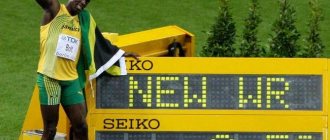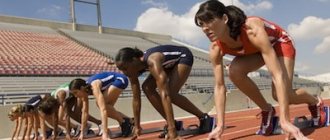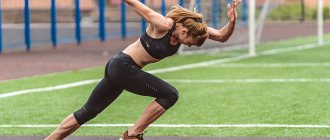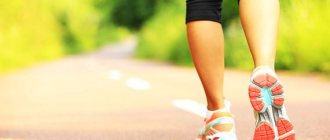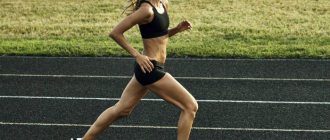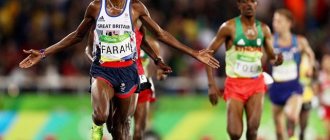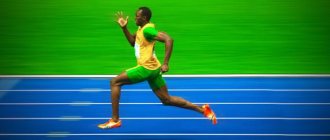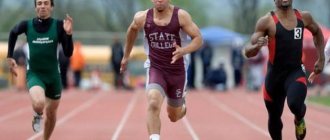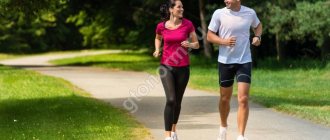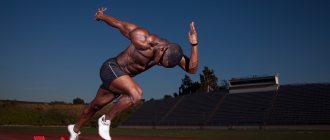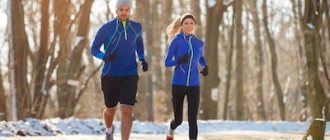Running as a sport continues to develop, new types of running appear that are still unknown to the masses. It is possible that they will remain unknown or, on the contrary, will be included in the Olympic program. Today there are about 15 disciplines that are included in the Olympiad program.
Types of running
Among the main types there are large groups: short, middle and long distances, hurdles and obstacles, relay running. There is also a non-standard classification: jogging, jerking, fartfleck, rogaining and cross-country.
Content
- 1 Middle and long distance running 1.1 History of middle and long distance running
- 2.1 Start and starting acceleration
- 3.1 Understanding running technique in general
How to run correctly
Following the conditions for effective running will allow you to get the maximum benefit from physical activity.
Tips for beginners
Beginners who decide to take up jogging will need to try out different techniques. You need to choose a method that is comfortable and convenient; the individual characteristics of the structure of the foot must be taken into account. A successful way of conducting classes is one that does not cause pain or muscle spasms during movements.
Running technique
Rules for safe jogging include recommendations for choosing the right position:
- Feet;
- torso;
- heads.
When choosing the method of placing the foot, the individual characteristics of the body are taken into account and are guided by the sensations that arise during the training process.
Step length
If your foot moves too far forward when running, you may lose balance and fall. This situation is especially dangerous for older people: the result is a broken limb.
A step that is too short is ineffective: such running causes rapid fatigue. The optimal length is when the center of gravity of the body completely coincides with the point of contact of the foot with the ground.
Correct positioning of the body and head
While running, it is necessary to ensure that the body does not bend in the lower back and there is no squatting. Similar errors occur in overweight teenagers and older people.
It is recommended to avoid tilting the body forward and leaning backward: this leads to excessive stress on the spinal column and joints, causing an exacerbation of osteochondrosis.
Middle and long distance running[edit | edit code]
Long distance running
Chart for increasing running distance in 9 weeks
Middle distance running
- running 800 and 1500 m.
Long distance running
is a run from 3,000 to 10,000 m.
History of middle and long distance running[edit | edit code]
Main article:
History of running
In Ancient Greece, not only short-distance running (stages 1 and 2) was practiced, but also medium and long distance running from 7 to 24 stages. The competition was held in one direction and back, with runners going around the turning posts and returning to the starting point.
Modern running over these distances originated in England in the 18th century. For men, the 800 and 1500 m and 42 km 195 m races were included in the program of the first Olympic Games of our time. In the classic long distances of 5000 and 10,000 m, men competed for medals at the Olympic Games in Stockholm (1912).
Among the world-famous athletes, the legendary Finnish runner P. Nurmi, a multiple Olympic champion in middle and long distance running, achieved outstanding success in the 20s of the last century. P. Nurmi is a kind of leader among track and field athletes of all times. In addition to 12 Olympic medals, including 9 gold, he set 40 world records at various running distances. A bright mark in the history of athletics was left by E. Zatopek (Czechoslovakia), who won 4 Olympic gold medals at the 1948 and 1952 Games. in running at distances of 5000, 10,000 m and marathon. The versatile runner E. Zatopek set 12 world records.
Women first competed in the 800m at the Olympics in 1928.
Then this distance, considered too difficult for the female body, was excluded from the Games program until 1960, when the Soviet runner L. Lysenko became the Olympic champion. In 1972 the program
The Games of the XX Olympics for women included the 1500 m race, and at this distance the Soviet runner L. Bragina was the first to win Olympic gold, setting a world record.
In 1988, the 10,000 m distance was included in the Olympic Games program, and again the first champion of the Games was the Soviet athlete O. Bondarenko. At the 1996 Olympics, S. Masterkova won gold medals at distances of 800 and 1500 m, and at the world championships in middle distance running, Russian athletes O. Egorova (2001), T. Tomasheva (2003 and 2005) won gold medals gg.) and ,M. Savinova (2011).
In men, the Olympic victories of domestic long-distance runners are associated with V. Kuts, who became the champion in 1956 (Melbourne) in the 5000 and 10,000 m races, and P. Bolotnikov, who won a gold medal in Rome (1960) in running at 10,000 m, and at middle distances - with Yu. Borzakovsky, who won the 800 m run at the Athens Olympics (2004).
At medium and long distances in recent years, the leaders, both men and women, are representatives of African countries (Ethiopia, Kenya, Morocco). At the London Olympics (2012), the world record holder at this distance D. Rudisha (Kenya) won the men's 800 m race; T. Makhloufi (Algeria) ran the fastest 1500 m; M. Farah won the 5000 and 10,000 m. (Great Britain).
Women's champions were: at 800 m - M. Savinova (Russia), at 1500 m - A. Chakir-Alptekin (Turkey), at 5000 m the Ethiopian runner M. Defar won, and at 10,000 m - her compatriot T. Dibaba .
Medium and long distance running technique[edit | edit code]
Read more
: Techniques for running for medium and long distances
Running over medium and especially long distances is an endurance exercise. To achieve high results at these distances, the correct running technique is important, which allows the runner to use energy sparingly to perform long-term intensive work and maintain a high running pace.
The speed of running over medium and long distances is lower than when running over short distances, arm movements are less energetic, the rise of the knee of the swing leg and the inclination of the torso are also less pronounced. The main indicator of running technique as the distance increases is the efficiency of movement.
When describing running technique, four parts are conventionally distinguished: start, starting acceleration, distance running, finishing.
Start and starting acceleration[edit | edit code]
High start excitement technique
In middle and long distance running, a high start is used. Before the start of the run, athletes are located 3 m from the start line. At the command “Start!” The runner stands in front of the starting line so that the strongest leg is at the line, and the other is placed half a step back and slightly to the side. In this position, the torso leans slightly forward, and the body weight is on the forward leg. The opposite arm is bent at the elbow and, together with the shoulder, is brought forward, the other arm is half bent and laid back. According to the rules, it is not allowed to rest your hand on the track. The runner's head is slightly lowered, and his gaze is directed slightly forward towards the track.
At the command “March!” or the starter's shot, maintaining a tilt of the torso and pushing off strongly with the legs while simultaneously vigorously moving the arms back and forth, the athlete begins to run. The first running steps are performed in an inclined position with acceleration and, gradually straightening up, the athlete begins free running along the distance. The main task of the start and subsequent acceleration at these distances is to get forward in order to take an advantageous position at the inside edge of the running track. To do this, in the first meters you need to develop a fairly high speed.
Distance running[edit | edit code]
Technique of running for medium and long distances
Modern technique of running for medium and long distances is characterized by a free sweeping step, the length of which reaches 160-220 cm, frequency - 3-4.5 steps/s. A distinctive feature of good running technique is also the ability to relax the muscles and give them rest during non-working moments.
The strongest runners place their leg, slightly bent at the knee, on a support mainly from the front of the foot, near the projection of the center of gravity, and then lower it onto the entire foot. This reduces the braking effect at the time of its installation and promotes a more even and smooth run.
An effective push-off is characterized by straightening the supporting leg in all joints, after which it bends at the knee joint, and the heel rises slightly above knee level. “Folding” of the swing leg at the knee joint is ensured by the previous movements with sufficient relaxation of the lower leg muscles. The movement of the leg forward is carried out due to the movement of the hip, which at this moment begins to play a leading role. If the strongest middle-distance runners lift the hip of the swing leg almost to the horizontal, then long-distance runners lift the hip of the swing leg somewhat less.
When running along a distance, the athlete keeps his torso straight, with a slight tilt (4-5°) forward. Moreover, the tilt of the body increases at the moment of repulsion and decreases at the moment of landing. When running, the arms are bent at a right or sharper angle and move freely back and forth in accordance with the movements of the legs, the shoulders are not tense and gently lowered. As the arm moves forward, the corresponding shoulder also moves forward, compensating for the movements of the opposite leg, arm and pelvis.
When running on a turn, the runner tilts his body slightly to the left towards the edge of the track, the right foot is turned with the toe towards the slope, and the arm of the same name moves with greater amplitude with the hand inward and the elbow further to the side. However, this adjustment during a turn is significantly less than during sprinting.
At medium and especially long distances, it is necessary to achieve smooth running and strive to reduce vertical oscillations of the center of gravity, which are much lower in highly qualified athletes.
In middle and long distance running, a clear breathing rhythm is very important, and it is necessary to exhale especially actively and correctly, since a full exhalation contributes to a full inhalation.
Finishing[edit | edit code]
Exercises that help master running technique
For middle distances, runners begin to finish, increasing their running speed over 150-250 m, for long distances - over 400-600 m. The tactics of running at these distances require the runner to run quickly in the remaining meters to the finish, using the rest of the reserve strength by increasing arm movements, torso tilt and step frequency. Using all energy capabilities and mobilizing will, the runner completes the distance, trying to cross the finish line earlier.
After finishing the run, beyond the finish line, you need to gradually slow down your running speed and start walking. A sudden stop after the finish line leads to falls and collisions.
Health running
Source: https://www.medefect.ru/so/prof-0008.shtml
| [td]» Publications » Health running |
Running is the most accessible form of exercise. To practice jogging, no special devices, equipment, or equipment are required.
Here you need only two things - desire and will. Health running, unlike other types of physical exercise, is also good because the loads can be easily adjusted in volume and intensity.
They can be long or short, rare or systematic.
Running is a means of improving the health of the whole body. The experience of using it to treat patients shows that even a neglected and sick body does not need rest, but reasonable physical activity, systematic and gradually increasing loads.
Long running at a moderate and even pace significantly improves and stimulates the activity of the cardiovascular and respiratory systems, develops the muscles of the abdomen, legs and back, strengthens bones, tendons, ligaments, and helps develop correct gait and posture.
In people who run, the likelihood of contracting colds sharply decreases, and the manifestations of dysfunction of all systems and organs that accompany old age are reduced. Running significantly enhances the performance of any person (both physical and mental), improves mood, relieves headaches and discomfort in the heart, and normalizes body weight.
Healthy running can be recommended to everyone - from children to the elderly. It is strictly contraindicated only for diseases such as aortic aneurysm, malignant hypertension, thrombophlebitis, and malignant diseases. You should also not jog if you have acute illnesses, such as colds or other diseases.
Health running is a run in which a distance of 1 km is covered in 5-10 minutes, which depends on the preparedness of each person. For people who constantly run, the loads can be very large - up to 60 km per week.
For beginners and patients, of course, these loads are unacceptable; 1-3 km per day is enough for them.
Anyone involved in recreational jogging should know that during running, the minute volume of the heart (minute volume is the amount of blood pushed by the heart muscle into the aorta in one minute) increases several times.
Anyone who decides to take up recreational running must remember that the loads during running should not exceed the body’s capabilities, because a person runs primarily not with his legs, but with his heart and lungs. It is better to do jogging individually, adjusting the load so as not to overwork or overload the heart and lungs.
Running should bring pleasure and joy, so you need to run at ease, easily and freely, adhering to a certain rhythm. The tolerance to running load is usually judged by the heart rate recovery reaction. The sooner the heart rate is restored after a distance has been covered, the more prepared the body is for the running load.
A lot has been written about the benefits of health-improving running, but few places can you read about how to walk and run correctly. In his book “Active Longevity” Academician A.A. Mikulin writes: “...smooth, slow walking by gravity - this is how most elderly people move - should cause a feeling of fatigue, since toxins are poorly removed from the body.
If, during a walk, even on short sections of the path, you walk briskly, quickly, with large steps, trying to step as hard as possible, leaning on your heel and planting your entire foot, so that strong muscle contractions, as well as blows and shocks of the whole body, cause a sharp complete cleansing of the body from toxins, then after such a walk a person feels not tired, but cheerful and energized.
You also need to firmly place your foot on the ground or floor, mainly on your heel, while running, running in place and during any exercises with jumping.
Running “on tiptoes” is not useful, since the shaking is weakened by the tension of the feet, they become tired, and the removal of waste worsens.
To gain maximum vigor and health, it is advisable to run daily for 15-20 minutes, 2-3 km, trying to place your foot on your heel as firmly as possible.
You need to get used to running very carefully and gradually.
On the first day, take ten quick steps, then, bending your elbows, run 5-10 steps. You need to breathe calmly. Take two steps - inhale through your nose, take two steps - exhale through your mouth.
When the “second wind” appears, inhalation and exhalation should be taken longer – four steps. As your body adapts to running, the walking distances should be reduced, and eventually you will learn to run two to three kilometers a day.
Older people should perform this exercise by alternating between running and walking every one and a half minutes.
At the same time, it is very important to note that such running is beneficial to our internal organs.
The heart, stomach, intestines, liver, kidneys and other organs of our body were formed over millions of years in conditions of very high human mobility, in conditions of daily shocks during running, fast walking, jumping, martial arts, etc.
Therefore, now, with our sedentary lifestyle, all these organs need help to cleanse them of toxins. They also need to “shake themselves up” properly. Neither the liver, nor the kidneys, much less the heart, can be “washed” or “cleaned” in any other way.
Therefore, I believe that with the help of running and fast walking in the air according to my system, or, if the weather does not permit, jogging and walking on the spot in the apartment, we consciously stimulate the self-cleansing processes of our internal organs.
But I repeat once again, you need to accustom your body to running very carefully and gradually, otherwise you can cause yourself great harm.”
D. Fedotov
“Health running” and other articles from the Disease Prevention section
Training program for long-distance running and marathon[edit | edit code]
The most important physical quality of long-distance runners is high aerobic capacity, which is necessary to maintain a steady and fast pace during a long race. The sources of energy used during the race are glycogen and free fatty acid. An example of a periodization model is given in the table.
- dominant energy system
: aerobic;
- ergogenesis
: distance 10,000 meters - 3% lactate system, 97% aerobic system; marathon - 100% aerobic system;
- main sources of energy
: glycogen, free fatty acid;
- limiting factor
: long-term muscular endurance;
- training goals
: long-term muscular endurance (all distances), strength endurance (distance 10,000 meters).
Periodization Model for Long Distance Running and Marathon
| Periodization | Oct. | Nov. | Dec. | Jan. | Feb. | March | Apr. | May | June | July | Aug. | Sep. | ||
| Prep. | Compet. | P | ||||||||||||
| Force | 8 /L | 6 MS, M | 6 SMV, MS, SV | 8 Conv. in the DMV | 14 Subject: DMV, MS, SV | Comp. | ||||||||
| Energy systems | Aerobic performance | Aerobic performance, Aerobic M | Aerobic performance, Aerobic M, lactate performance | Other activities | ||||||||||
Maximum strength less than 80% of the repeated maximum. Legend:
AA - anatomical adaptation, slave. - performance, competition. — competitive stage, comp. - compensation, conv. — conversion, sub. - support, DMV - long-term muscular endurance, SMV - medium-term muscular endurance, MC - maximum strength, M - power, SV - strength endurance, prep. - preparatory stage and P - transitional stage.
Read also[edit | edit code]
- Sprinting
- 800 meter run (training)
- Running 5000-15000 meters (training)
- Relay race
- Running with obstacles
- Jumping in athletics
- Throwing in athletics
- All-around athletics
- Classification and general characteristics of athletics exercises
- Running technique in athletics
- Athletics exercises
- Running technique
- Running technique in athletics
- Sprinting technique
- Medium and long distance running technique
- Relay running technique
- Rules for running competitions
- Athletics at school
- Sprint training
- Sprint running
- Stayer's running
Safety precautions
You should not move on to interval or speed work without any running training.
Jack Daniels, author of the book “From 800 Meters to the Marathon,” advises including speed work in preparation for long races only when the volume of running per week regularly reaches 40-50 km. In this case, speed work should be no more than 8% of the total weekly mileage. But this is precisely interval, intense running with alternating acceleration and rest.
Speed training must be preceded by a warm-up - light jogging for at least 10 minutes and joint exercises.
There are certain rules of behavior on the tracks - you cannot go onto someone else’s track during competitions. Collisions at these speeds almost always result in injury.
We have already written about shoes - they must fit perfectly to the foot. Choosing shoes for sprints is an important part of protecting yourself from injury. Sneakers must be the correct size and well laced.
Those runners who have recently suffered an injury should take special care when starting speed work. If you are not sure that everything has passed, you cannot move on to speed. Sprinting is a serious impact load, and it can negate all the progress in treatment.
